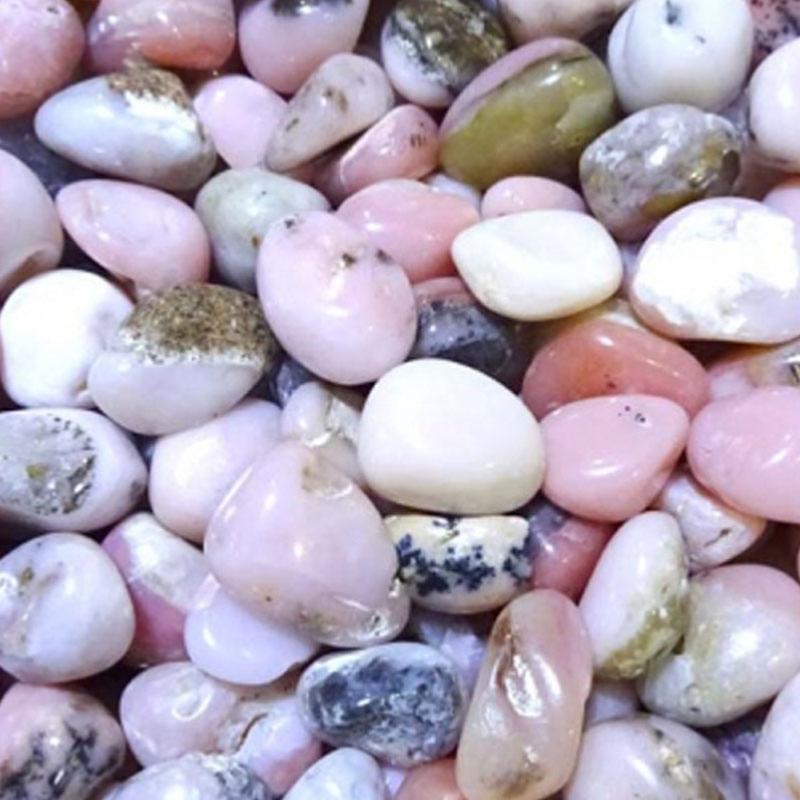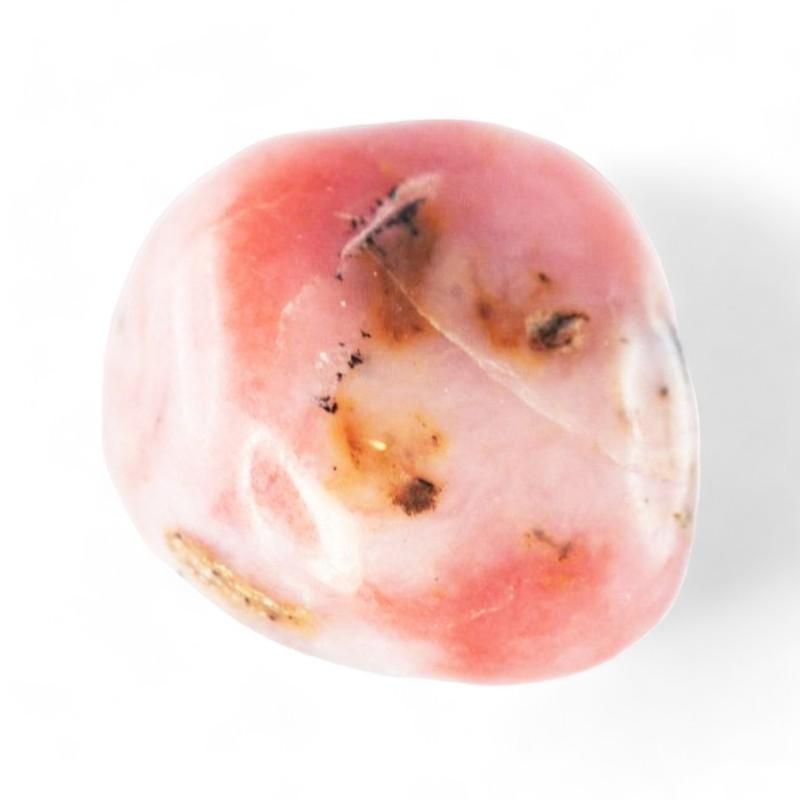Pink Andean Opal A (tumbled stone)
OPAR-0105-10
- Regular price
-
3,90€ - Regular price
-
- Sale price
-
3,90€
Couldn't load pickup availability
Learn more
OPAR-01
Origin: Peru
Grade: A
05-10g - About 20-25mm
10-20g - About 25-35mm
20-30g - About 35-45mm
Origin:
Peru
Grade:
A = good
Andean Pink Opal Tumbled Stone
Sold individually.
Weight to choose from 05-10g to 20-30g
Shapes and colors may vary from one stone to another
An opal is composed of hydrated silica, with traces of uranium, magnesium, calcium, aluminum, iron, arsenic, sodium and potassium. It also has a high water content which can reach up to 20% depending on the variety.
Opal forms during alternating wet and dry periods. Precipitation loaded with various elements infiltrates into the substrate. Then in dry periods, evaporation will allow the formation of upper layers of chalcedony and quartz.
The etymology of the word opal comes from the Sanskrit upala meaning precious stone. We notice that opal is the only gem that is splendid without any cutting first.
For decades, the origin of the magnificent colors of noble opals was not explained until 1965, when the scanning electron microscope appeared. Thus, scientists were able to highlight the structure of opals. Made up of spheres of varying dimensions, opals have a milky appearance; they are common opals. In noble opals, the spheres are of identical dimensions and the light then interferes and produces this incredible multi-colored appearance.
It should be noted that water has a great importance in the appearance and behavior of the opal. It is not uncommon to see raw opals presented to the public in containers filled with water.
Opal has a hardness of 5.5 to 6 on the Mohs scale. For comparison, diamond has the highest hardness, 10 on this same scale.
According to Greek mythology, opal was associated with Zeus's tears of joy after his victory against the titans. Her tears upon contact with the ground transformed into opals. This legend mainly concerns blue opal. It is a common opal in various shades of blue. It was even thought that opal gave its wearer powers of clairvoyance and divination.
Among the Romans, opal is a stone of hope. Pliny the Elder tells the story of Nonius, senator dismissed by Mark Antony (83 - 30 BC), because he did not want to give him an opal. Marc-Antoine absolutely wanted to offer it to Cleopatra. Nonius preferred to flee with only his precious opal and his collection of stones. According to an 18th century legend, Nonius opal was found in the ruins of Alexandria.
In ancient times, opal was considered a precious stone. In the Middle Ages, blonde women wore opal necklaces to preserve the color of their hair. Opal also had the name “ophthalmios” which literally translates as “eye stone”. Indeed, it was thought to have eye protection properties.
Many writers describe this stone by comparing it to fireworks, volcanoes, galaxies, etc. The Bedouins explained that this stone fell during storms enclosing lightning.
In India, a legend says that the Rainbow Goddess was so beautiful that she was constantly courted, even harassed. She then chooses to transform into opal.
However, opal was considered a stone of misfortune. A myth from a novel by Sir Walter Scott entitled Anne of Geierstein or the Daughter of the Mists, published in 1829, harmed the stone. Indeed, the heroine Lady Hermione died after her opal received holy water. She was accused of witchcraft. In a few months, the opal market suffered a 50% drop.
But a more reasonable explanation emerged: 19th century lapidaries and stone setters had difficulty working this stone without damaging it. The frequent breakage associated with this stone gave the opal a connotation of bad luck.
The main opal deposits are extremely numerous, numbering 3,000. They are located in Ethiopia, Australia, Peru, Madagascar, Germany, Indonesia, Turkey, New Zealand and Russia.
Pink opal is a so-called amorphous opal because it has no iridescence or opalescence. It is also said to be common in the absence of color schemes. Like all opals, pink opal contains water, which makes it particularly soft to the touch.
Pink opal has a color that can vary from very soft pink to more intense pink. This color is caused by the presence of manganese in the composition. Pink opal also goes by the name “Andean opal” or “Andean opal”. This opal also exists in blue.
This opal is found in a location between the Pacific coast and the Andes Mountains. This region near the Nazca Desert is known for its geoglyphs. For information, a geoglyph is a large drawing or pattern created on the ground. In fact, geoglyph literally means “engraving or chiselling of the earth”.
For the record, Shakespeare was particularly fond of this pink stone. This even though it is claimed that pink is more suitable for women.
Deposits are found in Peru ( Andean opal ), Australia, etc.
Pink Andean opal is a stone that soothes inner conflicts. Indeed, it is of great help to people who suffer from inferiority complexes. These people cannot flourish and live normally. They carry intense suffering within them.
Pink opal allows you to be much less demanding of yourself and reduce this obsession with achieving perfection. It generates self-acceptance and encourages you to review your goals.
Furthermore, this stone can be of great help during intimate blockages. It helps to overcome past trauma. It is a beautiful stone for healing buried emotions. Pink opal acts on emotional balance and relieves grief. It encourages healing of the heart and mind.
Wearing a pink opal creates greater openness towards others. It makes the person more cordial, friendly and diplomatic. Relationships with others are greatly improved.
This stone stimulates reflection and calms anger. It avoids errors of judgment, negative thoughts and anxiety. It encourages its wearer to develop their creativity and originality. Pink opal promotes intuition and allows good management of crisis situations.
Pink opal is recommended during the loss of a loved one, during a romantic breakup or during a betrayal. It causes healing of these emotional wounds and brings a feeling of peace and security.
Features
Color :
- Pink
Astrological sign:
Stone Type:
- Rolled Stones
Age :
Gender :



Pink Andean Opal A (tumbled stone)
- Regular price
-
3,90€ - Regular price
-
- Sale price
-
3,90€
Basé sur 8 avis soumis à un contrôle
- Pour plus d’informations sur les caractéristiques du contrôle des avis, la possibilité de contacter l’auteur de l’avis, les délais de publication et de conservation des avis, ainsi que les modalités de suppression ou modification des avis, merci de consulter nos CGU.
- Aucune contrepartie n’a été fournie en échange des avis, à l’exception des avis indiqués avec la mention "Récompensé et vérifié" et dont les modalités de contrôles sont disponibles ici.
- Les prénoms affichés avec un * ont été pseudonymisés à la demande de l'auteur.
-
6
-
1
-
0
-
0
-
1
Trier les avis
-
5/5VérifiéCollecté et vérifié par Avis Vérifiés
Vraiment rose, c’est bien
Cet avis vous a été utile ? Oui (0) Non(0)SignalerAvis du , suite à une expérience du par Virginie F.
Afficher les commentairesMasquer les commentaires -
4/5VérifiéCollecté et vérifié par Avis Vérifiés
bien
Cet avis vous a été utile ? Oui (0) Non(0)SignalerAvis du , suite à une expérience du par Léa L.
Afficher les commentairesMasquer les commentaires -
1/5VérifiéCollecté et vérifié par Avis Vérifiés
Les trois pierres sont abîmées et deux ont plusieurs trous.
Cet avis vous a été utile ? Oui (0) Non(0)SignalerAvis du , suite à une expérience du par NADIA S. N.
Réponse de laboiteacailloux.comJe suis désolé mais vous devriez vous renseigner sur les pierres avant de déposer ce type de commentaire. Toutes les opales roses même roulées sont toujours comme ça. Elles ne sont jamais lisses sauf si elles ont été modifiées artificiellement: on appelle ça stabilisée (injection de résine dans la pierre). Nous ne vendons pas sur notre site ce type de pierre: je suis désolé !
Afficher les commentairesMasquer les commentaires -
5/5VérifiéCollecté et vérifié par Avis Vérifiés
Rien à redire je suis très satisfaite et j'adore cette pierre.
Cet avis vous a été utile ? Oui (0) Non(0)SignalerAvis du , suite à une expérience du par Taina S. T.
Afficher les commentairesMasquer les commentaires -
5/5VérifiéCollecté et vérifié par Avis Vérifiés
Parfait.
Cet avis vous a été utile ? Oui (0) Non(0)SignalerAvis du , suite à une expérience du par Nadia v. N.
Afficher les commentairesMasquer les commentaires
- 1
- 2
-
100% SECURE PAYMENT
Paypal, credit card, check, transfer
-
FREE DELIVERY
from 40€ purchase
-
SATISFIED OR REFUNDED
14 days to change your mind
-
CUSTOMER SERVICE AVAILABLE
contact@laboiteacailloux.com
to receive all our offers, good deals and new products from La Boite à Cailloux




